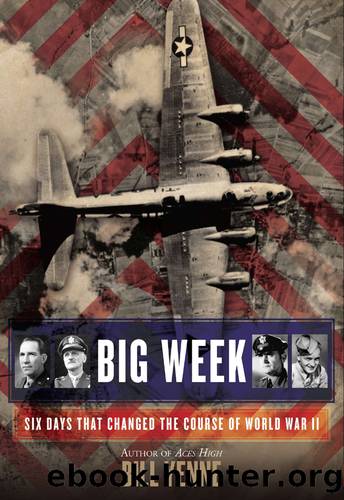Big Week by Bill Yenne

Author:Bill Yenne [Yenne, Bill]
Language: eng
Format: epub
ISBN: 9781101618967
Publisher: Penguin Publishing Group
Published: 2012-12-30T16:00:00+00:00
FIFTEEN
SUNDAY, FEBRUARY 20
Thanks to Wally Truemper’s excellent navigating, Ten Horsepower, the Flying Fortress piloted by Dick Nelson and Ron Bartley, caught up with the rest of the 351st Bombardment Group and took its place in a thousand-plane bomber stream that stretched for 150 miles across the skies over the North Sea.
Some of the elements of the 2nd Division would go nearly as deep as the 1st Division, almost 500 miles from East Anglia, to the city of Gotha, a place that earned its name in the eighth century when Charlemagne wrote that it was a place of “good water.” A capital first of the Duchy of Saxe-Gotha, and later of the Duchy of Saxe-Coburg-Gotha, the city was now home to the facilities of Gothaer Waggonfabrik (GWF). The company had originated in the nineteenth century as a builder of railway rolling stock but had branched into aircraft as early as 1914 and was currently manufacturing a variety of its own aircraft for the Luftwaffe, as well as being the largest manufacturer of Messerschmitt’s twin-engine fighters.
Other 2nd Division Liberators heading southeast on Sunday were flying toward Braunschweig, the city commonly known in English as Brunswick, about 440 miles from 2nd Division bases. Here, the targets included factories in the city’s northern suburbs, as well as at Helmstedt, about a dozen miles to the east, and Oschersleben, 20 miles to the southeast. The Braunschweig area was home to the engine maker Muhlenbau-Industrie AG (MIAG). Though MIAG’s stock in trade was power plants for Panther tanks and Jagdpanther armored vehicles, they were also a major manufacturer of engines designed by Daimler-Benz, and they produced components for Messerschmitt Bf 110 fighters.
The 1st and 2nd Divisions would be escorted by a greater number of fighters than had yet been launched by the USAAF on a single mission anywhere. It was a maximum effort, in which every available American fighter plane—18 fighter groups worth—was tapped for service, while the RAF also contributed 16 squadrons of Spitfires and some of its own Mustangs. Drawn from VIII Fighter Command, as well at the Ninth Air Force’s IX Fighter Command, there were 73 USAAF P-51 Mustangs, 94 P-38 Lightnings, and 668 P-47 Thunderbolts. The latter, being unable to accompany the bombers all the way to their targets, would, as they usually did on deep penetration missions, go as far as possible, return home to refuel, and pick up the bombers on their way out of Festung Europe.
The Flying Fortresses of the 3rd Division, meanwhile, would fly a far northern route which would not cross the paths of the other two divisions after leaving British airspace. Flying across the North Sea and over the northern part of Denmark, they approached northern Germany from over the Baltic Sea.
Their primary targets would be the huge Luftwaffe engineering facility and bomber crew training school at Tutow. The most distant on the 3rd Division target list, the buildings were clustered around the city of Posen. Located 140 miles inland from the Baltic, Posen was a historically Polish city known in Polish as Poznan.
Download
This site does not store any files on its server. We only index and link to content provided by other sites. Please contact the content providers to delete copyright contents if any and email us, we'll remove relevant links or contents immediately.
| Africa | Americas |
| Arctic & Antarctica | Asia |
| Australia & Oceania | Europe |
| Middle East | Russia |
| United States | World |
| Ancient Civilizations | Military |
| Historical Study & Educational Resources |
Before Topgun Days: The Making of a Jet Fighter Instructor by Dave Baranek(812)
Enemy Coast Ahead by Guy Gibson(700)
The SAS Training Manual by Chris McNab;(695)
The True Story of Catch 22 by Patricia Chapman Meder(596)
Comet! The World’s First Jet Airliner by Graham Simons(587)
Outlaws Inc. by Matt Potter(572)
Airborne by Tom Clancy(536)
The Wright Company by Edward J. Roach(534)
The Other Side of Airfix by Authur Ward(533)
Memoirs of a Stuka Pilot by Helmut Mahlke(517)
Beyond Band of Brothers by Richard D. Winters(512)
Hitler's Eagles by Chris McNab(500)
Air Warriors by Douglas Waller(480)
Boyd by Robert Coram(470)
Pegasus, The Heart of the Harrier: The History and Development of the World's First Operational Vertical Take-off and Landing Jet Engine by Andrew Dow(463)
Stormchasers by David Toomey(459)
Airborne (1997) by Clancy Tom(453)
Focke-Wulf Fw 190 by CHRIS GOSS(436)
I Always Wanted to Fly by Wolfgang W. E. Samuel(415)
